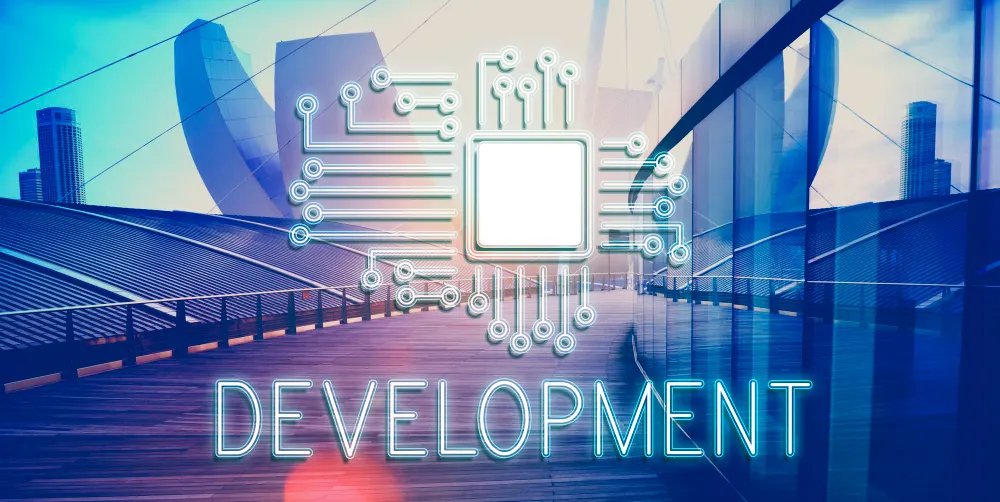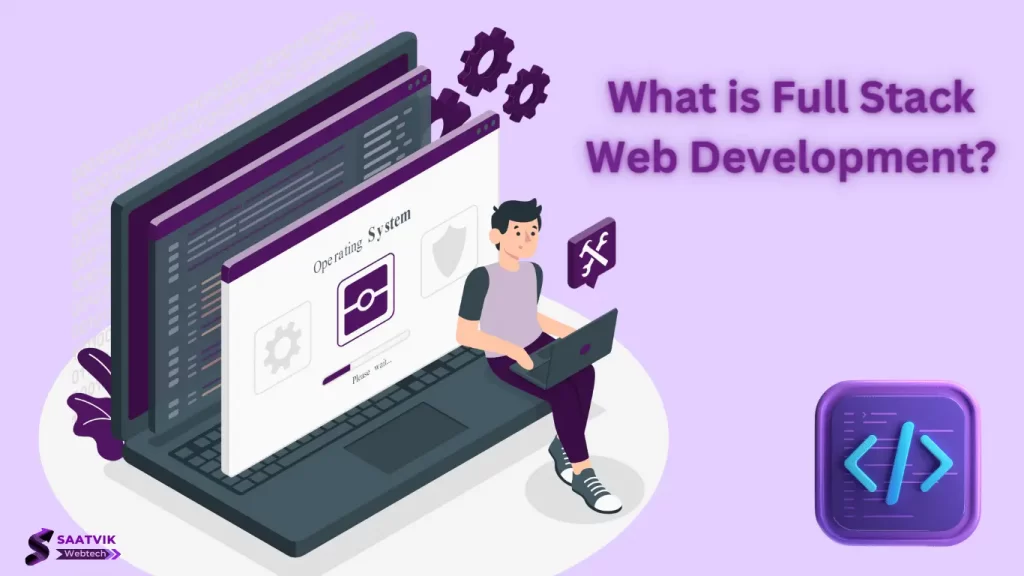Imagine building a house. Full stack web developers are the architects and contractors all in one; they design the look and feel of the house (front-end) and build the foundation and inner workings (back-end). This comprehensive approach allows them to create websites that are not only beautiful but also function smoothly and efficiently.
Full stack web development refers to the practice of building both the front-end and back-end components of a website or web application. The front end is the visible part of a website that users interact with, while the back-end comprises the server-side logic and database management.
Front-end development focuses on creating an engaging user interface using languages such as HTML, CSS, and JavaScript. This involves designing the layout, incorporating interactive elements, and ensuring responsive design for different devices.
On the other hand, back-end development involves working with databases, and server-side languages like Python or PHP, and handling the logic that powers the website. Back-end developers are responsible for managing server resources, optimizing performance, and ensuring smooth communication between the front-end and back-end components.
Being a full-stack developer means having the skills and knowledge to work on both the front-end and back-end aspects of a web application. It requires understanding various programming languages, frameworks, databases, and architectural patterns. Full-stack developers are versatile and can handle every aspect of a project, from initial design to final deployment.
Key Takeaways
- Full-stack web development involves building both the front-end and back-end components of a website or web application.
- Front-end development focuses on creating an engaging user interface using HTML, CSS, and JavaScript.
- Back-end development involves working with databases, and server-side languages like Python or PHP, and handling server-side logic.
- Full stack developers are skilled in both front-end and back-end development and can handle every aspect of a project.
- Understanding full stack web development is essential for both beginners and experienced developers.
Understanding Full Stack Web Development
Full stack web development is a comprehensive approach to building web applications that involves working on both the front-end and back-end aspects of a project. A full stack developer is responsible for handling various tasks throughout the development process, from designing the user interface to implementing server-side logic.
With their versatile skill set, full stack developers possess a deep understanding of the entire web development stack, including front-end technologies like HTML, CSS, and JavaScript, as well as back-end technologies such as databases, server-side programming languages, and frameworks.
A full stack developer’s role is to bridge the gap between different layers of an application, ensuring seamless communication and functionality. By combining their knowledge of both front-end and back-end development, full stack developers are well-equipped to create robust, dynamic, and user-friendly web applications.
A full stack developer’s responsibilities may include:
- Designing and developing the user interface (UI) using HTML, CSS, and JavaScript
- Implementing server-side logic and handling database operations
- Ensuring cross-platform compatibility and responsiveness
- Performing testing and debugging
- Optimizing application performance
- Collaborating with designers, developers, and stakeholders
To better understand the role of a full stack developer, let’s take a look at a comparison between front-end and back-end development in the table below:
| Front-End Development | Back-End Development |
| Focuses on creating user-facing components and interfaces | Handles server-side logic and database operations |
| Involves technologies like HTML, CSS, and JavaScript | Utilizes programming languages like Python, Java, or PHP |
| Deals with the visual and interactive aspects of an application | Manages data storage, retrieval, and manipulation |
As you can see, full stack web development encompasses both front-end and back-end development, allowing full stack developers to create comprehensive and efficient web applications. Their expertise in various technologies and their ability to work on different aspects of a project make them highly versatile and valuable assets in the web development industry.
What Kind of Websites Do Full Stack Developers Build?
- E-commerce Platforms: Think of online stores like Amazon or Etsy. Full stack developers create the product pages you browse (front-end), as well as the shopping cart functionality, secure payment systems, and inventory management (back-end).
- Social Media Platforms: Like Facebook, Twitter, or Instagram. Full stack developers build the user profiles, newsfeeds, and the ability to post, like, and share content. They also manage the databases that store all that user data.
- Content Management Systems (CMS): Platforms like WordPress or Wix that let people build websites without coding. Full stack developers create the core structure of these systems – the drag-and-drop interfaces, content storage, and backend administration.
- Interactive Web Applications: These go beyond simple websites, from online games to mapping tools like Google Maps. Full stack devs handle the complex user interactions, real-time data updates, and server-side logic.
 Front-End Web Development
Front-End Web Development
Front-end web development is a crucial aspect of full stack web development. As a front-end developer, you play a vital role in creating the user-facing components of a website or web application. This involves designing and building the visual elements, layout, and interactive features that users interact with.
Essential Skills for Front-End Web Development
To excel in front-end web development, you need to acquire several key skills:
- HTML: The foundation of every web page, HTML (Hypertext Markup Language) is used to structure and present content on the internet.
- CSS: Cascading Style Sheets (CSS) is responsible for the visual presentation and styling of web pages, allowing you to control colors, fonts, layouts, and more.
- JavaScript: A programming language that enables interactivity and dynamic content on websites, JavaScript is essential for creating engaging user experiences.
Tools and Frameworks for Front-End Development
Front-end web development is made more efficient and effective with the use of various tools and frameworks. These provide ready-made solutions and streamline the development process. Some popular choices include:
- Code Editors: Code editors like Visual Studio Code, Sublime Text, and Atom help developers write and manage their code more efficiently, providing features like syntax highlighting and code completion.
- Version Control Systems: Tools like Git allow developers to track changes to their code, collaborate with team members, and easily revert to previous versions when needed.
- Front-End Frameworks: Frameworks like React, Angular, and Vue.js provide reusable components and pre-defined structures to speed up development and enhance code maintainability.
Full Stack Development with Front-End Skills
While front-end web development focuses on the user interface and experience, it is an integral part of full stack development. A full stack developer combines front-end skills with back-end knowledge to develop end-to-end web applications. By possessing front-end web development skills, you gain a solid foundation to become a well-rounded full stack developer.
Next, we will explore the world of back-end web development and its role in full stack development.
 Back-End Web Development
Back-End Web Development
In the world of full stack web development, back-end web development forms a crucial component. It focuses on the server-side of web applications, handling the logic and functionality that users don’t directly interact with. By understanding the role of back-end development, you can better appreciate the scope and complexity involved in full stack web development.
Full Stack vs Front-End vs Back-End
Before delving into the specifics of back-end web development, let’s briefly compare it to front-end and full stack development. The front-end is responsible for creating the user interface and ensuring a seamless and visually appealing experience. On the other hand, back-end development encompasses server-side tasks such as data management, database integration, and application logic. Full stack web development combines both front-end and back-end skills to create end-to-end solutions.
Full Stack Programming Languages
As a back-end developer, you’ll need to be proficient in various programming languages to build robust and scalable web applications. Some commonly used programming languages for back-end development include:
- Python: Known for its simplicity and versatility, Python is widely used for back-end development, especially in data-intensive applications.
- Java: Renowned for its stability, Java is a popular choice for enterprise-level applications, where reliability and security are critical.
- PHP: Well-suited for web development, PHP is known for its ease of use and integration with popular databases like MySQL.
- Ruby: With its elegant syntax and focus on developer productivity, Ruby is often favored for building web applications using the Ruby on Rails framework.
Databases: SQL and NoSQL
Back-end developers also interact with databases to store, retrieve, and manage data efficiently. The two main types of databases used in web development are SQL and NoSQL.
SQL (Structured Query Language) databases, such as MySQL and PostgreSQL, use a structured approach for storing data in a tabular format. They are known for their consistency and reliability, making them suitable for applications with complex relationships between data.
NoSQL (Not Only SQL) databases, like MongoDB and CouchDB, offer flexibility and scalability, allowing for the storage of unstructured or semi-structured data. They are often chosen for applications handling large amounts of data or requiring high-speed data access.
Having knowledge of both SQL and NoSQL databases is essential for back-end developers, enabling them to make informed decisions based on the specific requirements of their projects.
 Web Architecture and REST APIs
Web Architecture and REST APIs
In full stack web development, understanding web architecture and REST APIs is crucial. Web architecture refers to the overall structure and design of a web application, including how different components interact and communicate with each other. REST APIs (Representational State Transfer Application Programming Interfaces) provide a standardized way for different software systems to communicate and exchange data over the Internet.
Web architecture plays a vital role in enabling effective communication between the front-end and back-end of a web application. It determines how information flows between these layers and ensures seamless integration and functionality.
REST APIs, on the other hand, act as a bridge between different layers of a web application. They allow the front-end to make requests to the back-end and retrieve data or perform actions. REST APIs adhere to a set of principles, including using standardized HTTP methods such as GET, POST, PUT, and DELETE, and utilizing uniform resource identifiers (URIs) to represent and access resources. This makes them highly versatile and scalable, allowing developers to build robust and flexible web applications.
When developing a full stack web application, it is essential to design a solid web architecture and implement REST APIs effectively. This ensures efficient communication between different parts of the application and enables seamless data exchange, enhancing the overall user experience.
Model-View-Controller (MVC) Architecture
In full stack web development, the Model-View-Controller (MVC) architecture plays a crucial role in organizing and separating different components of an application. MVC is a design pattern that provides a structured approach to building web applications, promoting modularity, code reusability, and maintainability.
The MVC architecture consists of three interconnected components:
- Model: The model represents the data and business logic of the application. It encapsulates the data and provides functions to manipulate and access it. In the context of full stack web development, the model interacts with the database and performs CRUD (Create, Read, Update, Delete) operations. By separating data handling from the user interface, the model ensures data integrity and enhances scalability.
- View: The view is responsible for presenting the user interface of the application to the user. It includes HTML, CSS, and JavaScript elements that render data from the model and interact with the user. With this view, web developers can create visually appealing and user-friendly interfaces, enhancing the overall user experience. By separating the view from the model and the controller, developers can easily change the presentation layer without affecting the underlying logic.
- Controller: The controller acts as an intermediary between the model and the view. It receives user input from the view, manipulates the data in the model, and updates the view accordingly. The controller ensures the application’s business logic is executed correctly and facilitates communication between the other components. By separating the controller from the view and the model, developers can modify the application’s behavior without affecting the user interface.
The MVC architecture brings several benefits to full stack web development:
- Separation of concerns: MVC separates the user interface, business logic, and data layers, making the codebase more modular and easier to maintain.
- Enhanced development efficiency: By dividing the development tasks among different components, MVC allows multiple developers to work on different parts of the application simultaneously, improving productivity.
- Code reusability: The modular structure of MVC enables developers to reuse code across different applications or within the same application, reducing redundant code and promoting efficient development practices.
Overall, the MVC architecture is widely adopted in full stack web development due to its ability to streamline development processes, enhance code organization, and improve application scalability.
 Responsive Design and User Experience
Responsive Design and User Experience
Responsive design and user experience are crucial components of full stack web development, particularly in front-end web development. By implementing responsive design techniques, developers can ensure that websites and applications adapt seamlessly to different devices and screen sizes, providing an optimal user experience.
As more and more users access the internet on mobile devices, it has become essential for websites to be responsive and mobile-friendly. This not only improves the usability of the site but also enhances its search engine visibility by complying with Google’s mobile-first indexing.
A responsive design enables a website to fluidly adjust its layout and content based on the size of the screen. This ensures that users can easily navigate and interact with the site, regardless of whether they are using a desktop computer, laptop, tablet, or smartphone.
Front-end developers play a vital role in creating responsive designs by utilizing HTML, CSS, and JavaScript. They use media queries to apply different styles to the website based on screen size, ensuring a consistent and user-friendly experience across devices.
Benefits of Responsive Design:
- Improved User Experience: Responsive websites provide a seamless experience, allowing users to navigate and interact with the content intuitively.
- Increased Reach: With the growing number of mobile device users, having a responsive website allows you to reach a broader audience.
- Search Engine Optimization: Responsive design is a crucial factor in search engine rankings, as search engines prioritize mobile-friendly sites in their results.
- Cost-Effective: Rather than building separate websites for different devices, responsive design allows you to have a single, adaptable website for all platforms.
By prioritizing user experience through responsive design, front-end developers contribute significantly to the success of full stack web development projects. They create visually appealing, intuitive interfaces that enhance user engagement and satisfaction, ultimately driving the success of web applications and websites.
What Is Full Stack Web Development With Version Control and Collaboration
In full stack web development, effective collaboration and efficient management of code is crucial for successful project execution. This is where version control systems like Git come into play. Git is a widely used distributed version control system that allows web developers to track changes, collaborate seamlessly, and ensure the integrity of their codebase.
With Git, multiple developers can work on the same project simultaneously without conflicts or loss of data. It enables developers to create branches, work on specific features or fixes, and merge their changes back into the main codebase effortlessly. This collaborative workflow enhances productivity and reduces the chances of introducing bugs or conflicts in the code.
Web developers can also leverage Git to revert to previous versions of their code if needed. This ability to maintain a historical record of changes provides a safety net and enables developers to experiment or make changes with confidence, knowing they can easily roll back if necessary.
Moreover, Git facilitates effective communication and collaboration within development teams. Developers can use Git’s built-in features like pull requests, code reviews, and issue tracking to provide feedback, discuss changes, and resolve conflicts. This ensures better cohesion among team members and leads to a more cohesive and robust codebase.
In summary, Git and version control systems are indispensable tools for web developers engaged in full stack development. They provide a structured and collaborative approach to code management, fostering teamwork, enhancing productivity, and ensuring the smooth and efficient development of web applications.
| Benefits of Version Control in Full Stack Development | Benefits of Collaboration in Full Stack Development |
|
|
 The Future of Full Stack Web Development
The Future of Full Stack Web Development
As technology continues to advance at a rapid pace, the field of full stack web development is poised for an exciting future. With the increasing demand for integrated and efficient web applications, the role of full stack developers will become even more vital in the coming years.
One emerging trend in full stack web development is the adoption of progressive web applications (PWAs). PWAs are web applications that combine the best of both web and mobile experiences, allowing users to access them seamlessly across different devices. With their ability to offer offline functionality, push notifications, and smooth user experiences, PWAs will revolutionize the way we interact with web applications.
Another key area that full stack developers need to keep an eye on is the rise of artificial intelligence (AI) and machine learning (ML) technologies. Incorporating AI and ML into web development can enhance the efficiency and intelligence of web applications, enabling them to provide personalized user experiences, automate repetitive tasks, and improve decision-making processes.
Furthermore, as the Internet Of Things (IoT) continues to expand, full stack web developers will play a crucial role in building applications that connect and communicate with various IoT devices. This integration of web development and IoT will allow for the creation of smart homes, cities, and industries, improving efficiency and convenience in our daily lives.
The world of full stack web development is always evolving. By mastering both front-end and back-end technologies, you’ll have the power to build the incredible websites and applications of tomorrow. Are you ready to start your full stack journey?
